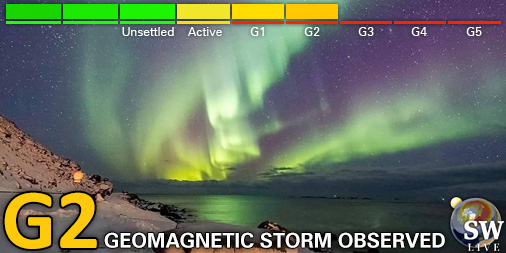Viewing archive of Wednesday, 17 July 2013
Daily bulletin on solar and geomagnetic activity from the SIDC
Issued: 2013 Jul 17 1303 UTC
SIDC Forecast
Solar flares
Eruptive (C-class flares expected, probability >=50%)
Geomagnetism
Active conditions expected (A>=20 or K=4)
Solar protons
Quiet
| 10cm flux | Ap | |
|---|---|---|
| 17 Jul 2013 | 114 | 007 |
| 18 Jul 2013 | 113 | 019 |
| 19 Jul 2013 | 113 | 012 |
Bulletin
Solar activity is still low, with only few C-class flare reported during last 24 hours. The Catania sunspot group 30 (NOAA AR 1791) and NOAA AR 1793 still have potential to produce C-class, and possibly M-class flares. The CACTUS software reported the CME, first seen in the SOHO/LASCO C2 field of view at 03:48 UT on July 16, with the speed of about 400 km/s and width of 120 degrees. From the currently available data it seems that the bulk of the CME mass is directed northward of the Sun-Earth line. The arrival of the CME at the Earth is not very probable, but we do expect arrival of the CME driven shock wave. The Earth is inside a slow solar wind with the speed of 350 km/s. The interplanetary magnetic field magnitude is about 4 nT. The arrival of the fast flow from the low-latitude coronal hole in the northern hemisphere which reached the central meridian on July 16 is expected on July 18. The CME driven shock wave associated with the CME on July 16, might arrive at the Earth on July 20. We expect minor to major geomagnetic disturbance due to arrival of the fast flow in the following 48 hours.
Today's estimated international sunspot number (ISN): 054, based on 13 stations.Solar indices for 16 Jul 2013
| Wolf number Catania | /// |
| 10cm solar flux | 114 |
| AK Chambon La Forêt | 010 |
| AK Wingst | 006 |
| Estimated Ap | 005 |
| Estimated international sunspot number | 050 - Based on 18 stations |
Noticeable events summary
| Day | Begin | Max | End | Loc | Strength | OP | 10cm | Catania/NOAA | Radio burst types | |
|---|---|---|---|---|---|---|---|---|---|---|
| None | ||||||||||
Provided by the Solar Influences Data analysis Center© - SIDC - Processed by SpaceWeatherLive
All times in UTC
Current data suggests there is a moderate possibility for aurora to appear at the following middle latitude regions in the near future
Surgut, SyktyvkarCurrent data suggests there is a slight possibility for aurora to appear at the following middle latitude regions in the near future
Moscow, Perm, YaroslavlLatest news
Latest forum messages
Support SpaceWeatherLive.com!
A lot of people come to SpaceWeatherLive to follow the Sun's activity or if there is aurora to be seen, but with more traffic comes higher server costs. Consider a donation if you enjoy SpaceWeatherLive so we can keep the website online!

Latest alerts
17:00 UTC - Geomagnetic activity
Moderate G2 geomagnetic storm (Kp6) Threshold Reached: 16:34 UTC
15:30 UTC - Geomagnetic activity
Minor G1 geomagnetic storm (Kp5) Threshold Reached: 15:20 UTC
14:30 UTC - Geomagnetic activity
Strong G3 geomagnetic storm (Kp7) Threshold Reached: 14:18 UTC
13:30 UTC - Geomagnetic activity
Moderate G2 geomagnetic storm (Kp6) Threshold Reached: 13:21 UTC
13:18 UTC - Hemispheric Power Index
The OVATION model predicts the Hemispheric Power Index to reach 125GW at 14:01 UTC
Space weather facts
| Last X-flare | 2025/03/28 | X1.1 |
| Last M-flare | 2025/04/15 | M1.2 |
| Last geomagnetic storm | 2025/04/15 | Kp6+ (G2) |
| Spotless days | |
|---|---|
| Last spotless day | 2022/06/08 |
| Monthly mean Sunspot Number | |
|---|---|
| March 2025 | 134.2 -20.4 |
| April 2025 | 124.1 -10.1 |
| Last 30 days | 124.7 -16.6 |






